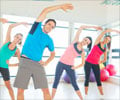A new study has revealed that there exists an extraordinarily precise built-in exercise monitor that evaluates how hard the body works.
Researchers from the University of Exeter found that an individual’s own sense of how hard he or she is working matches up exactly with actual level of exertion, measured by heart-rate and oxygen uptake.For the study, people were asked to exercise at various levels of intensity on a scale of six to 20, with six being completely inactive and 20 being on the verge of exhaustion.
The researchers determined the amount of exertion purely by the individual, who made a judgement on how hard to work based on his or her interpretation of the scale.
The team simultaneously monitored the person’s heart-rate and oxygen uptake, which are the most widely-used measures of physical exertion.
In almost all cases the results matched exactly the levels that would be predicted for each specific number on the six to 20 scale.
This demonstrates our ability to judge precisely how hard our bodies are working, said Professor Roger Eston, Head of the University of Exeter’s School of Sport and Health Sciences.
Advertisement
Prof Eston added that his research could lead to a more personalised approach to exercise, with personal trainers and gym instructors putting the responsibility on their clients to judge their own appropriate level of exercise intensity.
Advertisement
This approach could help keen gym-users to sharpen their fitness and make their exercise regimes more effective, he explained.
However, he added that the main benefit could be on those who are new to exercise.
“People are often nervous of going to gyms for the first time because they think they will be unable to perform the exercises that their instructor asks them to do,” Prof Eston said.
“Taking this new approach, a gym instructor would ask a customer to exercise at a particular level of perceived exertion rather than, for example, requesting ten minutes running at 10km an hour,” he added.
Source-ANI
LIN/P











